The Vacuum Car Is the Breakthrough That Just Keeps Breaking
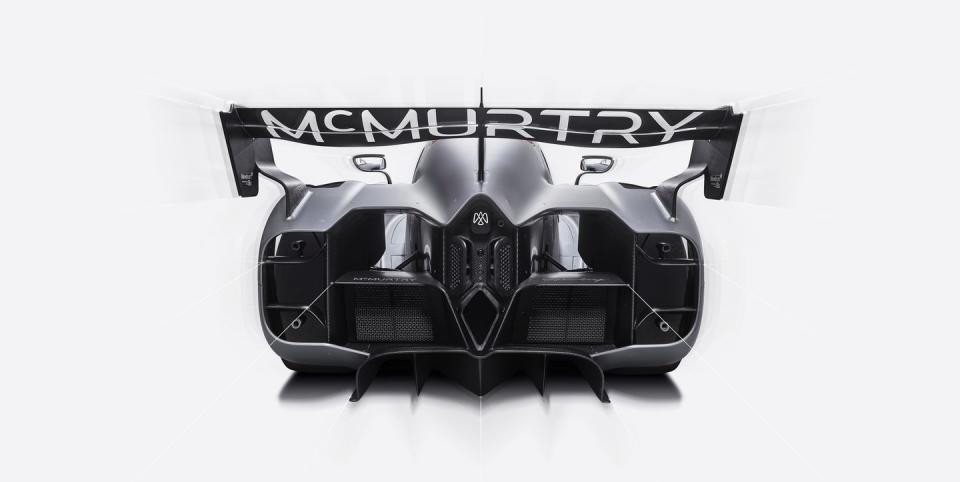

The distant wail of an electric motor cuts through the ambient hum. There’s a shhh-whoosh of moving air, and a sports car the size of a Victorian eyeglass case rockets past the grandstands at something like Mach 8. The crowd erupts in oohs and aahs and incredulous laughter. What the hell was that?
This story originally appeared in Volume 14 of Road & Track.
SIGN UP FOR THE TRACK CLUB BY R&T FOR MORE EXCLUSIVE STORIES
On a nearby video wall, cameras track the McMurtry Spéirling as it shoots up the 11th Duke of Richmond’s driveway. On the screen, it looks over-fast and under-scaled, like a Micro Machines toy. Dust swirls as it jukes through Molecomb Corner, the Goodwood Hillclimb’s perilous 90-degree left-hander, fixed to the ground as if by magic. For the Spéirling, that magic is fan aerodynamics.
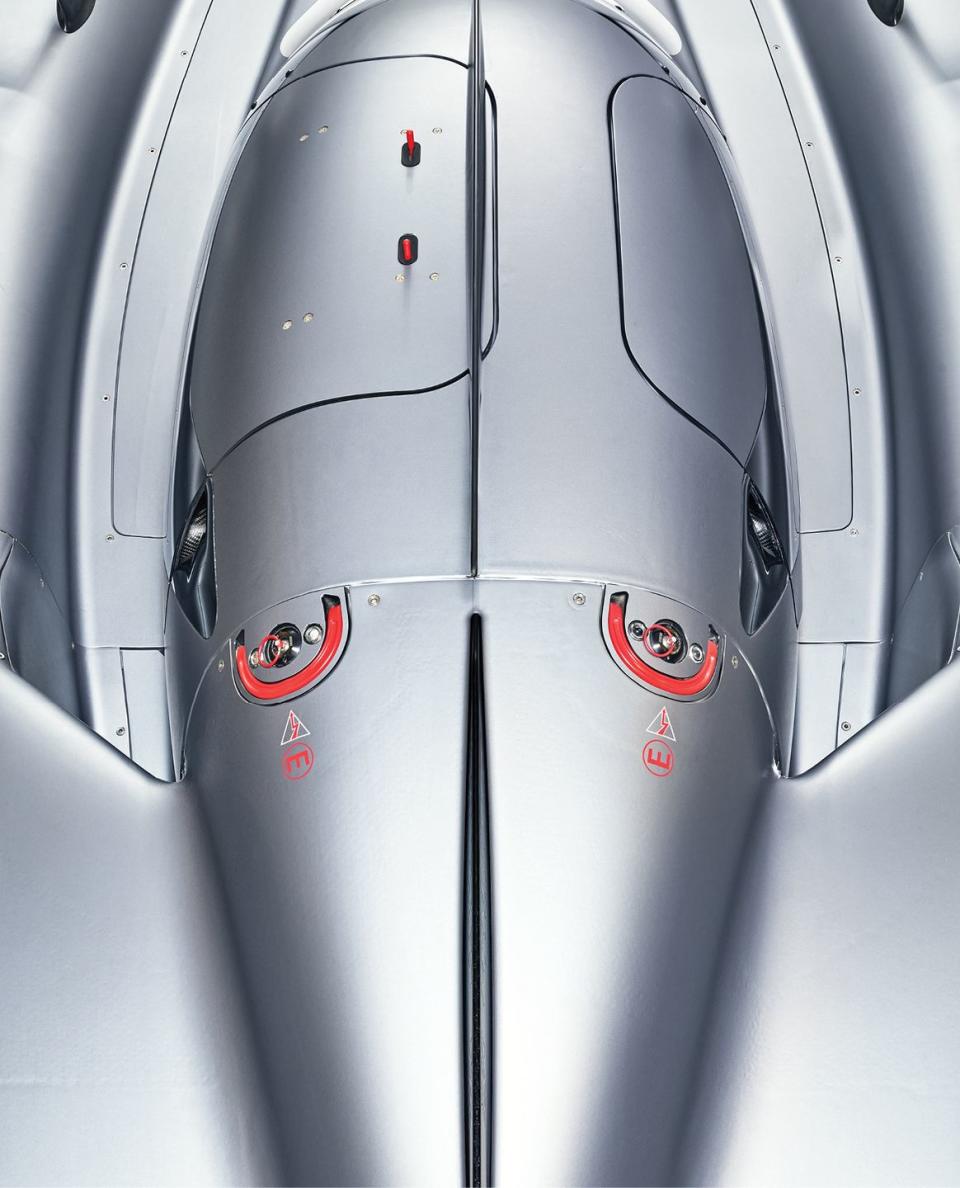
Fan cars are a motorsport engineering breakthrough that keeps trying to break through. The concept is simple and effective, like a hovercraft in reverse: Surround the bottom of a car with movable skirts, creating a plenum chamber that holds its seal at high speeds while traveling over tarmac and curbing, then install a fan or two to evacuate the air. As the air accelerates, it creates a low-pressure zone that pulls the car toward the ground, per the Bernoulli principle. Voilà! Downforce without wings.
Fan aero is a motorsport engineer’s dream. With an external wing, negative lift (i.e., downforce) increases with the square of a car’s speed, and drag is the cost of doing business. In contrast, fan cars generate downforce as soon as the fan starts spinning, and they do it without the drag a wing produces as it mashes against the air.
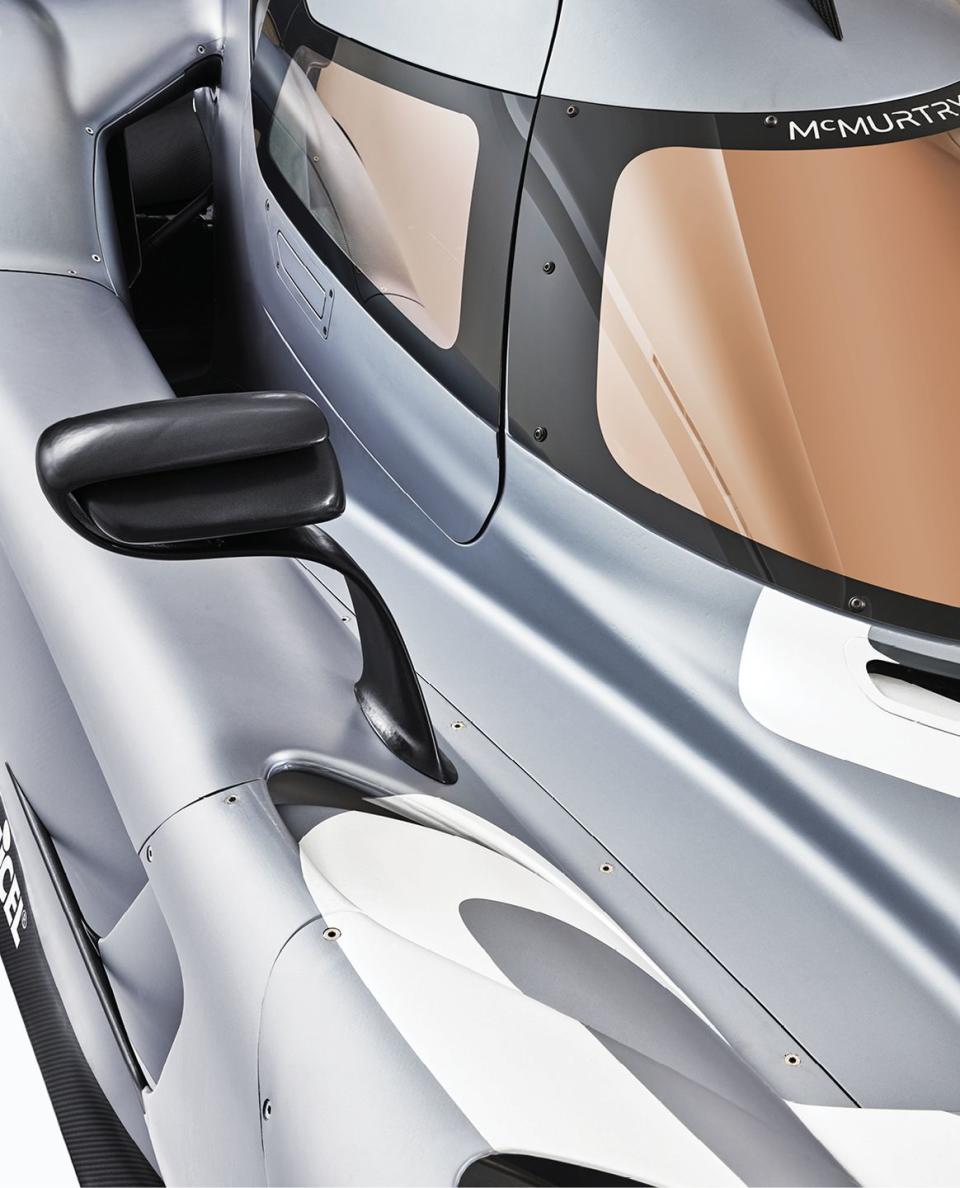
“With conventional aerodynamics, the forces just keep increasing with speed,” explains Willem Toet, a professor of motorsport engineering at the University of Bolton in the U.K. and a former head aerodynamicist for the Ferrari and BMW Sauber F1 teams. “That applies to both drag and downforce. In a fan car, the fan is operating at the speed that you determine. You can go to maximum [downforce] at zero speed, and it will give you an acceleration right off the line and maximum in low-speed corners.”
While less effective in high-speed corners, fan cars have the edge over wings for distributing downforce evenly. “If you place it sensibly, a fan car also has the advantage of being centrally located,” Toet says. “So when you change the power of the fan, you’re not changing the aerodynamic balance in the vehicle, just how much [downforce] you’re generating.”
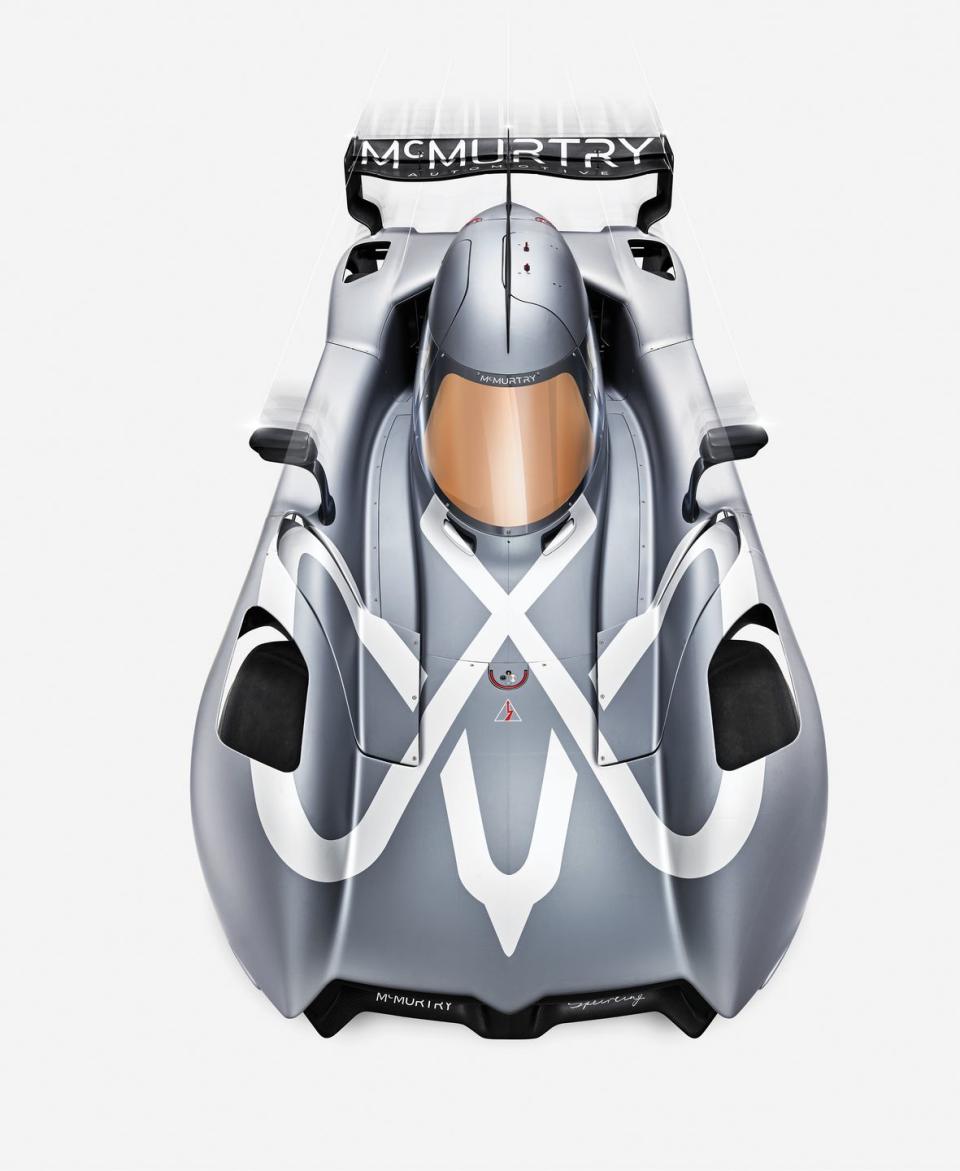
From a driver’s perspective, fan aero could also improve the craft and the spectacle of auto racing. “You can sit at 150 miles an hour nose to tail around a corner, and you wouldn’t lose any performance,” says Max Chilton, McMurtry development driver and IndyCar and F1 veteran. “With any other downforce, if you’re in dirty air, you lose it. In F1 cars, single-seaters, or anything with downforce, the racing is compromised because you can’t follow. This will completely cure that problem.”
With twin electric-powered fans and proprietary ground-effects bodywork, the 2205-pound McMurtry Spéirling prototype generates more than double its weight in downforce, making it strikingly effective in the tight bends of Goodwood’s 1.16-mile hill-climb course. With the footprint of an F1 car from the Sixties, the Spéirling—it means thunderstorm in Irish—sprints onward, blitzing past a centuries-old flint wall dubbed the “meat grater.” Driver Alex Summers, a British Hillclimb Championship winner, settles into a flat-out final sprint and crosses the finish line at 149.1 mph, just under the Spéirling’s gearing-limited maximum of 150 mph.

The run is a scorcher at 40.05 seconds, putting the Spéirling atop the board for 2022’s Goodwood Festival of Speed Qualifying Shootout and priming it for Chilton—absent from Goodwood on Saturday to attend a wedding—to attempt a record-setting run the next day.
David McMurtry, an Irish engineer and billionaire captain of the measurement-equipment industry who once worked on the Concorde’s axial-flow turbojet engines, founded McMurtry Automotive. The electric-sports-car startup based in Gloucestershire has returned fan aero to racing tarmac for the first time since the Brabham BT46B won the Swedish Grand Prix in 1978. Eight years before then, the Chaparral 2J—the earliest competition fan car in history—first raced at Watkins Glen with Jackie Stewart at the wheel. Despite these milestones, it’s been a largely unfulfilling five decades for fan cars.
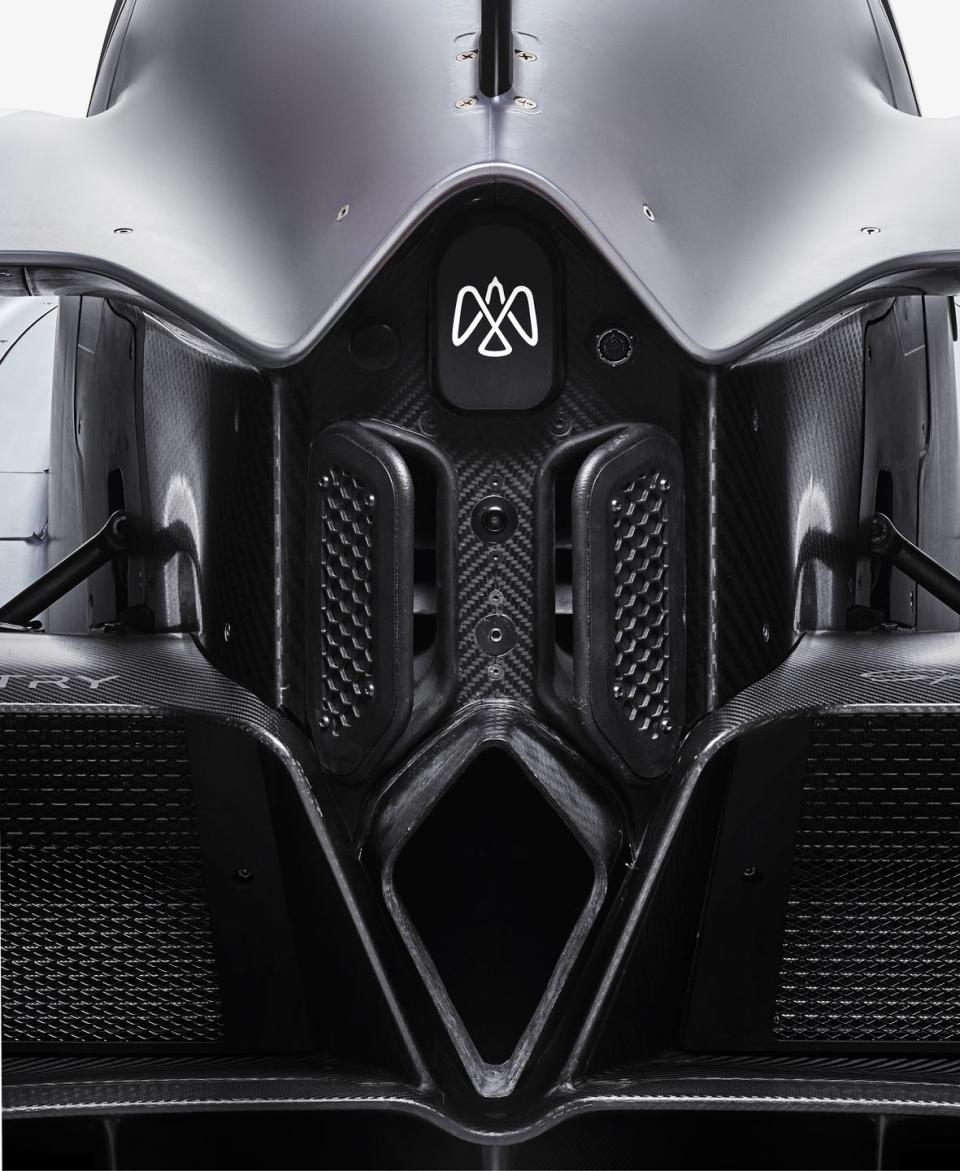
Chaparral 2J
Chaparral was in a bind. After years of building and fielding successful racing cars loaded with aerodynamic wonders, the team and its principal, Jim Hall, needed a new performance edge. McLaren drivers Bruce McLaren and Denny Hulme were dominating Can-Am. The formerly no-rules racing series had, in 1969, banned movable aerodynamics devices, such as the suspension-mounted wings that were among Chaparral’s primary innovations. That same year, McLaren swept all 11 races in the series, leaving Chaparral’s low-wing 2H racing car in the dust.
As the legend goes, a young racing fan handed Hall a crayon sketch, inspiring the development path that led to the world’s first fan car. Hall would lean heavily on the General Motors R&D center, which he’d worked with for years, to build something groundbreaking.
Throughout the final years of the Sixties, the Chaparral 2J fan car took shape. The main body was fiberglass, with a rear deck fashioned out of aerospace-style honeycomb panels to resist the outside atmosphere’s deep desire to crush it as the fans evacuated air from the plenum. Initial testing revealed uncontrollable oversteer with the fans on, so engineers ensconced the entire engine bay within the plenum area to keep vacuum pressure centered.
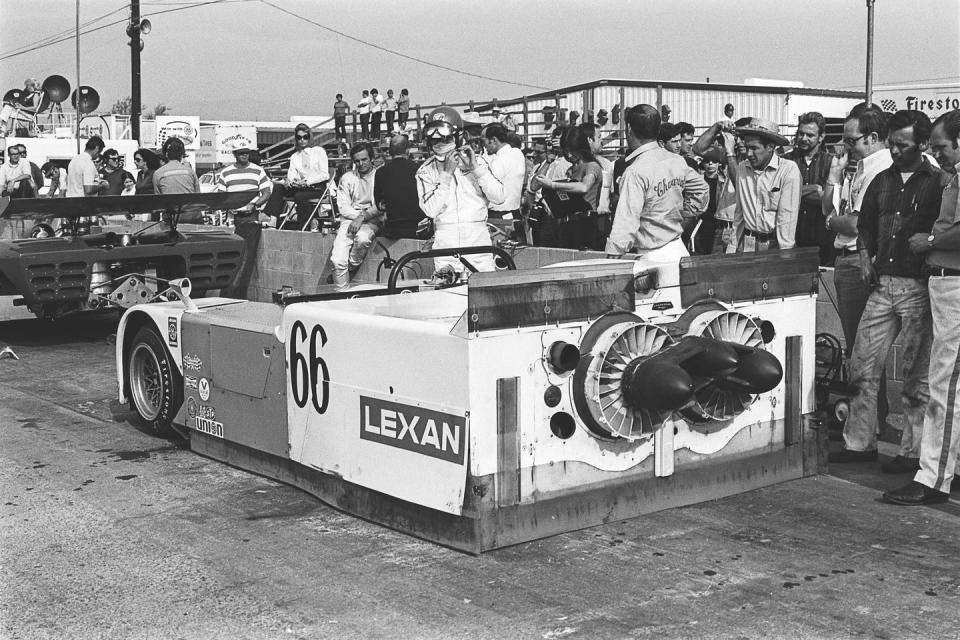
A 465-cid aluminum Chevrolet big-block V-8 paired with a semiautomatic three-speed transaxle provided motive force. A separate engine powered two axial fans lifted from a military tank engine. Using pulleys and belts and running at wide-open throttle, a 247-cc, 55-hp Rockwell JLO two-stroke, two-cylinder snowmobile engine drove the fans. Leading edges on the fan vanes were reinforced to survive strikes from fast-moving debris. As testing at Hall’s own Rattlesnake Raceway in Texas demonstrated, all sorts of stuff would inevitably get sucked into the blades.
Over time, an elaborate system of skirts took shape, fabbed out of General Electric’s Lexan polycarbonate plastic. A series of cables guided the skirts to rise and fall with suspension deflection, keeping them just above the track surface. An articulated apron designed to flip 180 degrees to manage encounters with track detritus was held forward by flaps driven by vacuum pressure. With the total plenum area at around 7400 square inches, and the fans maintaining a pressure of 0.25 psi inside it, the system could generate as much downforce as the car’s weight.
In his memoir Faster! A Racer’s Diary, Stewart remembers getting behind the wheel of the 2J at Watkins Glen for its first competitive outing. On race day, the 2J was slow out of the gate, owing to its semiautomatic transmission. Stewart found his footing, but mechanical issues reared up. “In the fourth lap, I’d moved past Peter Revson to take third,” he wrote. “As I was closing in on Dan [Gurney], a vapor lock forced me into the pits, and then, back out for only seven laps, I lost the brakes completely, which forced me to call it a day.”
Driver Vic Elford, who replaced Stewart after Watkins Glen, brought the 2J home in sixth place at the next Can-Am race at Road Atlanta. It was the only race the 2J finished that season, as reliability issues continued to vex the team. More ominously, race organizers met behind the scenes to debate the 2J’s legality. The skirts, they eventually ruled, were a “movable aerodynamic device.” The Chaparral 2J was history. It was eight years before the next fan car hit the track.
Brabham BT46b
If you’d wandered into the pits at the 1978 Swedish Grand Prix, you might have wondered why Brabham-Alfa Romeo’s racing car had a plastic trash-can lid sticking out from under its rear wing. The makeshift shield was to keep other F1 teams from eyeballing the business end of the world’s second fan car ever to enter competition.
Rewind to the previous year. In working up the Brabham BT46, designer Gordon Murray gambled that ditching conventional radiators in favor of surface coolers would lower the car’s drag and give Brabham a shot against the dominant Ferrari and Lotus teams. According to veteran F1 engineer David North, who was Murray’s assistant at the time, the team soon realized the airstream was passing over the outside of the panels, bypassing the cooling fins altogether. “It didn’t have much drag, but it wasn’t cooling either,” North recalls. “So we gave up on the idea.” The radically designed, cutting-edge BT46 needed a major reboot, and they rushed to find a solution.
“We realized a good place to put a radiator would be on top of the [Alfa Romeo flat-12] engine,” North says. “It was a great big space with nothing in it, but the only way we could get air to it would be with a fan.” The ideas started flowing. “We obviously were aware of sliding skirts from the Chaparral 2J and from the Lotus 78,” North remarks. “If we had a fan, we could suck air from underneath the car like the 2J did, so it’s not an aerodynamic device, but an aerostatic device. We could also use the fan to pull air through the radiator.”
The team posited that if they could prove the system’s primary function was cooling and its aerodynamic effects were secondary, they had a shot at getting the BT46B through scrutineering. It worked. “We were legally obliged to use the engine to drive the fan,” North acknowledges, so Murray designed the fan system to have reduction gears connected to the gearbox shaft, running at engine speed. Mechanics installed a slipper clutch to reduce gearchange shocks, and a dog clutch allowed them to disconnect the drive while working on the car with the engine running.
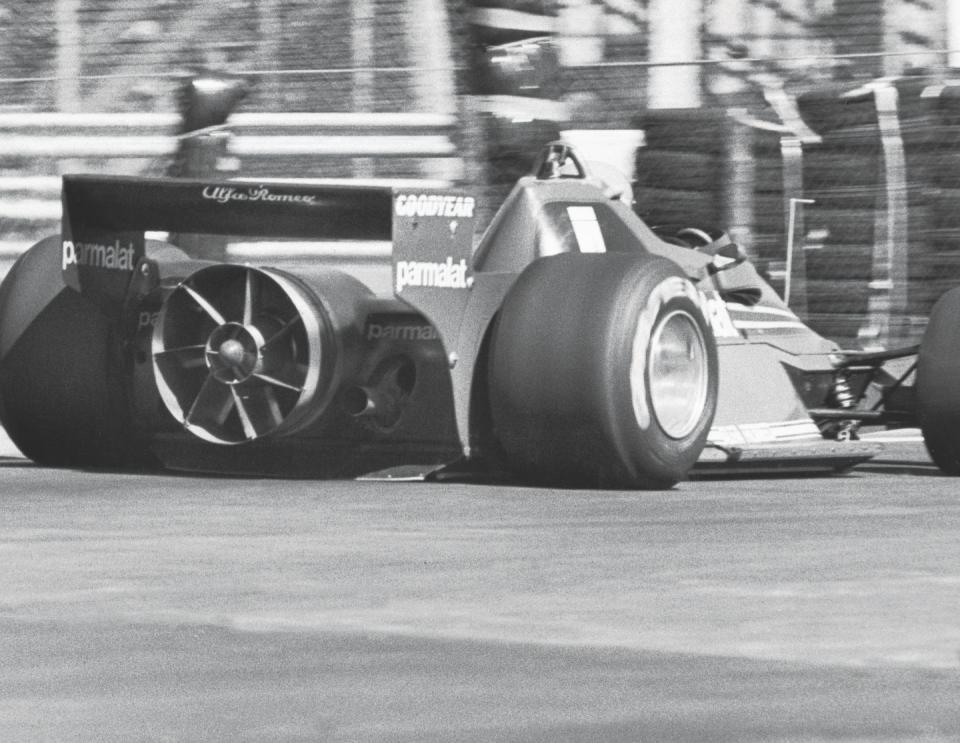
They installed an axial-flow fan with carbon-reinforced nylon blades. These were promptly damaged by sucked-up debris from the ground, so Murray replaced them with cast magnesium. A simple arrangement of skirts designed to rub on the ground, with strips of ultrahigh-molecular-weight polyethylene attached to protect the edges, completed the sides of the plenum. “They lasted a race distance but not much more,” North admits. Steel leaf springs held the side skirts to the ground, and sliding panels sealed off the uprights, driveshafts, and wishbones. The rear skirt was angled rearward and sealed easily by suction, but the front skirt was a more complex issue.
“That was the tricky problem—how to design a front skirt that’s able to climb over debris and doesn’t create a big high-pressure region ahead of it,” North recalls. “[We] drilled one-inch holes through the front skirt, and behind there was a sailcloth bag, a double bag running across behind it, and holes inside that bag as well.” The idea was for dynamic air pressure coming through the holes to inflate the airbag to counteract the dynamic load on the front of the skirt.
Drivers John Watson and Niki Lauda soon put the BT46B to the test at the 1978 Swedish Grand Prix. After qualifying third, Lauda moved past pole sitter Mario Andretti in the Lotus to finish first, while Watson, who’d qualified second, suffered a stuck throttle, spun, and retired from the race. On balance, Brabham’s second development gamble had paid off.
“The authorities deemed [the BT46B] legal,” North continues. “They said, ‘You can have your points in the race, but we’re going to change the rules at the end of the season, so you can’t have it next season.’ Bernie [Ecclestone, owner of Brabham] was under a lot of political pressure from other teams, so he voluntarily withdrew the car on the basis that we’d keep our nine points from winning the race in Sweden. So that was the end of the 46B.”
What would have happened had the BT46B continued to race? “BT47 would have been far more sophisticated,” North says, with “a much more effective skirt system and twin counterrotating fans. The only limit would have been the driver’s ability to withstand lateral acceleration. Perhaps the entire cockpit could have been designed to rotate about the roll axis. Who knows?”
This Is Not a Vacuum Cleaner
The Brabham BT46B fan car shares a large, circular protrusion at its rear with the new Gordon Murray Automotive (GMA) T.50 road car. Both are fans. And both were put there by designer Gordon Murray. Despite family resemblance, the T.50 and the BT46B are dissimilar vehicles whose fans serve very different purposes.
The BT46B, which the Brabham F1 team ran at the 1978 Swedish Grand Prix, was a sucker car. Its fan created a low-pressure zone under the car that pulled the BT46B toward the ground, thereby generating downforce without the drag penalty of a wing (or, if the FIA asked, it cooled the engine).
The fan nestled into the T.50’s rear bodywork is part of a less radical but more sophisticated aerodynamics scheme. Those who read car manuals might remember that Murray’s 1994 McLaren F1 used two 120-mm fans to accelerate underbody air up over a steep section of the rear diffuser, which created around five percent more downforce (and a two percent reduction in drag).

The T.50’s 400-mm fan operates on the same principle but is more comprehensive. Like the F1’s fans, it reduces turbulence and air separation over the entire width of its rear diffuser, in concert with other aerodynamic components. For example, in its highest-downforce setting, the fan activates, a set of rear spoiler flaps flip up, and the diffuser ducts open. The result is 50 percent more downforce instantly.
The system has other settings, including the low-downforce Streamline mode for Autobahn sprints, which drops the flaps below the bodywork by –10 degrees, stalls the diffuser, and cranks up the fan to its maximum 7000 rpm to create a “virtual longtail” that reduces overall drag by 12.5 percent. A Brake Boost mode extends the flaps up 45 degrees, opens the diffuser ducts, and maxes out the fan, doubling downforce and reducing the T.50’s stopping distance from 150 mph by 10 meters.
For the most brutal acceleration, V-Max Boost mode reduces drag to a minimum and isolates fan power to the T.50’s 48-volt starter-generator, eliminating parasitic drag on the naturally aspirated V-12 and delivering up to 690 hp for a short period.
“The Brabham was a really simple, crude device,” Murray said in a GMA video. “It was a vacuum cleaner.”
Red Bull X2010
A decade ago, Red Bull designer Adrian Newey opened his pencil box, and the Red Bull X2010 flowed out. It was a fictional racing car envisioned for Gran Turismo 5 after franchise founder Kazunori Yamauchi challenged Newey to create the fastest F1 car possible, free from rules and regulations. With Newey’s imagined fan aero system, the X2010’s theoretical lateral acceleration number was off the charts at 8.75 g’s. Sebastian Vettel would likely have faced serious medical issues if he’d tried to race it at Monza. We’ll never know.
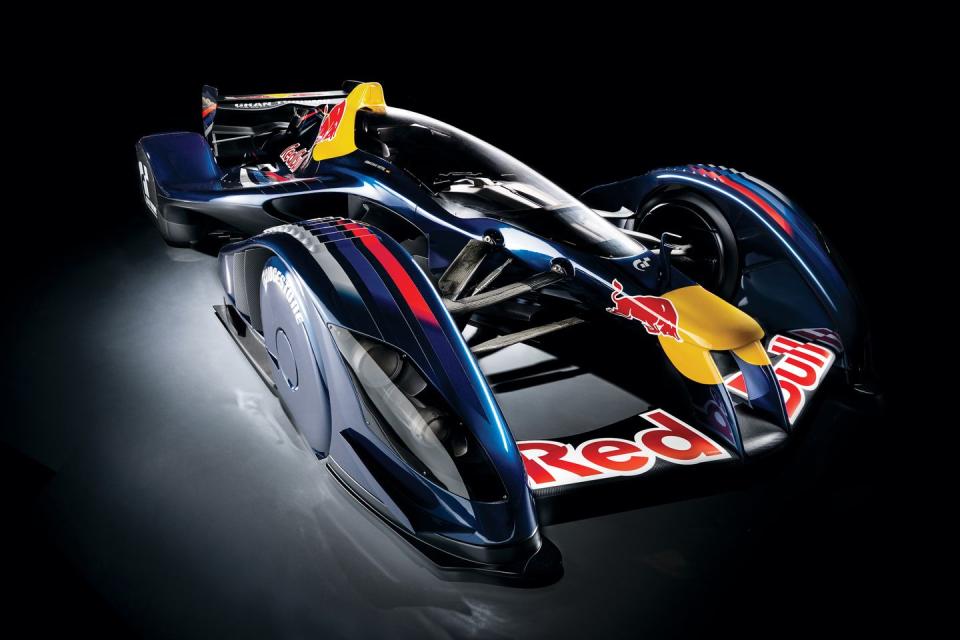
McMurtry SeÉIRLING
We call them fan cars, but the skirts are the whole game. “You’ve got this frictional component, which generates heat,” observes Thomas Yates, McMurtry Automotive managing director. “It’s a really harsh environment. But once you can get to a solution that works, then it unlocks a huge number of other opportunities.”
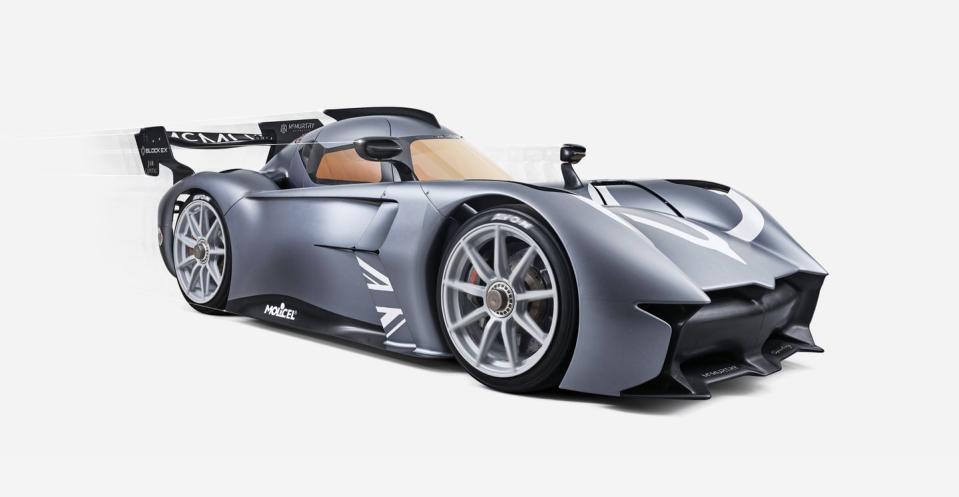
With no racing-series organizers to placate, McMurtry engineers operate in a world where any solution within the budget allocated is fair game and rulebooks don’t tamp down innovation.
“We did a load of research and concluded that the real reasons for fans being banned in the Seventies were predominantly political,” Yates says. “There were some technical challenges, but nothing that couldn’t be resolved with modern-day technology.”
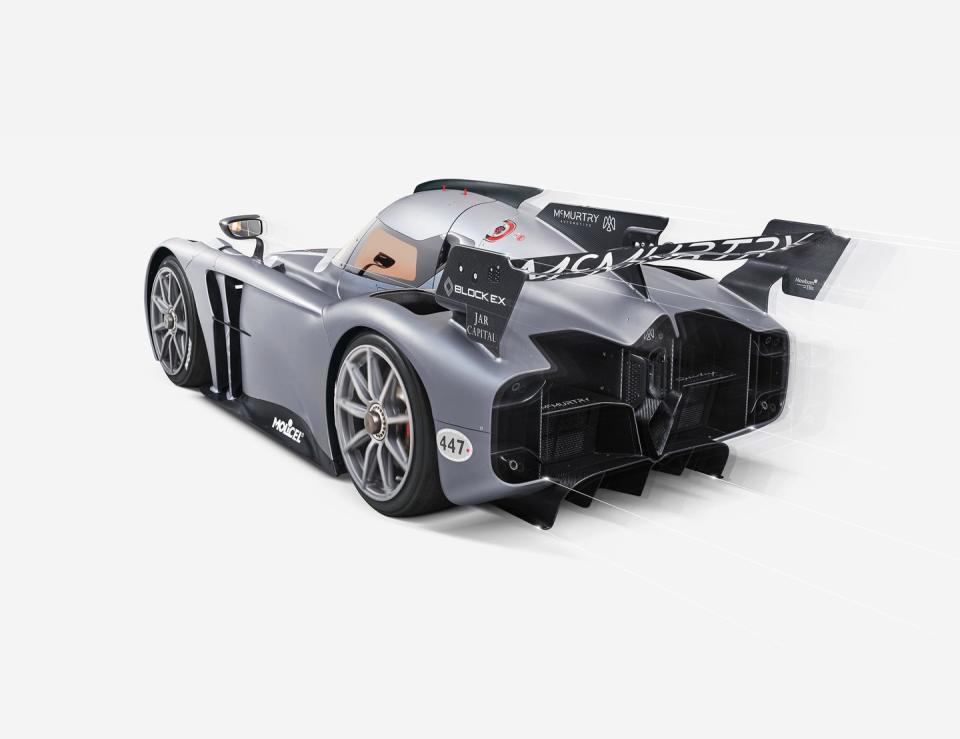
Once the development team committed to making the Spéirling a fan car, Yates concludes, they developed the entire vehicle around fan downforce, and it “became fundamental to the design of the car and the chassis.”
The Goodwood Record
On Sunday, at the Goodwood Festival of Speed, Max Chilton slips beneath the canopy of the McMurtry Spéirling prototype. During qualifying the day before, driver Alex Summers had already bested the official hill-climb record of 41.6 seconds, set in 1999 by Nick Heidfeld in a McLaren MP4-13 F1 car. During the final shootout today, Chilton is going for the official record. He’s also taking on an unofficial record of 39.9 seconds set by Romain Dumas during the Qualifying Shootout in 2019 in the electric Volkswagen ID.R.
Chilton’s launch out of the gate looks ballistic, as if it should be measured in feet per second. His run looks flawless and terrifying, yet Chilton is as calm as if on a parade lap.

“When you’re in it, you just put so much belief in this thing,” Chilton remarks. “It’s got so much grip. But from the outside, you think, ‘How on earth is he doing that?’ But it’s got so much performance from the downforce that you just trust it.”
Chilton’s run gets the same response from the crowd, whose oohs and aahs suggest this stuff never gets old. It’s a racing car with fan aero, the first one since 1978 to emerge victorious. Chilton blasts over the finish line at 149.1 mph. His time: 39.08 seconds.
You Might Also Like

 Yahoo Autos
Yahoo Autos 